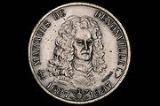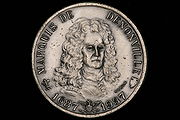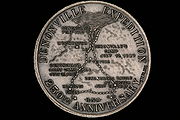
Jacques-René de Brisay de Denonville, Marquis de Denonville
Encyclopedia
Jacques-Rene de Brisay de Denonville, Marquis de Denonville (10 December 1637 – 22 September 1710) was Governor General of New France
from 1685 to 1689 and was a key figure in the Beaver Wars
.
Replacing Joseph Antoine de LaBarre, Denonville set out to make King Louis XIV proud. The Iroquois
Confederacy had been a nuisance for half a century, hampering New France's efforts to establish itself as a profitable colony
. Although France
and England
were at peace, in June 1687, Denonville sent Sieur de Troyes north from Montreal
with a hundred men (most likely the troupes de la marine
), to capture the English fur trading posts on Hudson Bay
. The victory was swift and profitable; word of the French attack would not reach the English for months. Denonville then set out with a well-organized force to Fort Frontenac
, where they met with the 50 hereditary sachem
s of the Iroquois Confederacy from their Onondaga council fire. These 50 chiefs constituted the entire decision-making strata of the Iroquois. They had been lulled into meeting under a flag of truce. Denonville seized, chained, and shipped the 50 Iroquois chiefs to Marseilles, France, to be used as galley slaves. He then ravaged the land of the Seneca. Before he returned to New France, he travelled down the shore of Lake Ontario
and created Fort Denonville
at the site where the Niagara River
meets Lake Ontario. This site was previously used by La Salle
for a fort named Fort Conti
from 1678 to 1679, and was later used for Fort Niagara
, which still exists to this day.
The destruction of the Seneca land infuriated the Iroquois Confederacy, who considered the Seneca the most honoured nation of the Confederacy. This, coupled with the dishonourable loss of their sachem
s, demanded they set out to terrorize New France as never before. Denonville's regulars were dissolved and dispersed to towns across the land, attempting to protect New France's homes and families. Forts were abandoned. The Iroquois destroyed farmsteads and whole families were slaughtered or captured. On August 4, 1689, Lachine
, a small town adjacent to Montreal
, was burned to the ground. Fifteen hundred Iroquois warriors had been harassing Montreal
defences for many months prior. Denonville was finally exhausted and defeated. His tenure was followed by the return of Frontenac, who replaced Denonville as governor for the next nine years (1689–1698). Frontenac had been arranging a new plan of attack to mollify the effects of the Iroquois in North America and realized the true danger the imprisonment of the sachems created. He located the 13 surviving leaders, and they returned with him to New France in October 1698.
When Denonville had returned to France, the king continued to show his confidence in Jacques-René by appointing him as a tutor to the children of the royal household.
A medal commemorating the 250th anniversary of the 1687 Denonville Expedition was created by the Rochester Numismatic Association
in 1937. The medal obverse has an image of the Marquis de Denonville while the medal reverse shows the timeline and path of the expedition.
Governor General of New France
Governor General of New France was the vice-regal post in New France from 1663 until 1760 and was the last French vice-regal post. It was replaced by the British post of Governor of the Province of Quebec following the fall of New France...
from 1685 to 1689 and was a key figure in the Beaver Wars
Beaver Wars
The Beaver Wars, also sometimes called the Iroquois Wars or the French and Iroquois Wars, commonly refers to a series of conflicts fought in the mid-17th century in eastern North America...
.
Replacing Joseph Antoine de LaBarre, Denonville set out to make King Louis XIV proud. The Iroquois
Iroquois
The Iroquois , also known as the Haudenosaunee or the "People of the Longhouse", are an association of several tribes of indigenous people of North America...
Confederacy had been a nuisance for half a century, hampering New France's efforts to establish itself as a profitable colony
Colony
In politics and history, a colony is a territory under the immediate political control of a state. For colonies in antiquity, city-states would often found their own colonies. Some colonies were historically countries, while others were territories without definite statehood from their inception....
. Although France
France
The French Republic , The French Republic , The French Republic , (commonly known as France , is a unitary semi-presidential republic in Western Europe with several overseas territories and islands located on other continents and in the Indian, Pacific, and Atlantic oceans. Metropolitan France...
and England
England
England is a country that is part of the United Kingdom. It shares land borders with Scotland to the north and Wales to the west; the Irish Sea is to the north west, the Celtic Sea to the south west, with the North Sea to the east and the English Channel to the south separating it from continental...
were at peace, in June 1687, Denonville sent Sieur de Troyes north from Montreal
Montreal
Montreal is a city in Canada. It is the largest city in the province of Quebec, the second-largest city in Canada and the seventh largest in North America...
with a hundred men (most likely the troupes de la marine
Troupes de la marine
See also Troupes de Marine for later history of same Corps.The Troupes de la Marine , also known as independent companies of the navy and colonial regulars, were under the authority of the French Minister of Marine, who was also responsible for the French navy, overseas trade, and French...
), to capture the English fur trading posts on Hudson Bay
Hudson Bay
Hudson Bay , sometimes called Hudson's Bay, is a large body of saltwater in northeastern Canada. It drains a very large area, about , that includes parts of Ontario, Quebec, Saskatchewan, Alberta, most of Manitoba, southeastern Nunavut, as well as parts of North Dakota, South Dakota, Minnesota,...
. The victory was swift and profitable; word of the French attack would not reach the English for months. Denonville then set out with a well-organized force to Fort Frontenac
Fort Frontenac
Fort Frontenac was a French trading post and military fort built in 1673 in Kingston, Ontario, Canada. It was positioned at the mouth of the Cataraqui River where the St. Lawrence River leaves Lake Ontario , in a location traditionally known as Cataraqui...
, where they met with the 50 hereditary sachem
Sachem
A sachem[p] or sagamore is a paramount chief among the Algonquians or other northeast American tribes. The two words are anglicizations of cognate terms from different Eastern Algonquian languages...
s of the Iroquois Confederacy from their Onondaga council fire. These 50 chiefs constituted the entire decision-making strata of the Iroquois. They had been lulled into meeting under a flag of truce. Denonville seized, chained, and shipped the 50 Iroquois chiefs to Marseilles, France, to be used as galley slaves. He then ravaged the land of the Seneca. Before he returned to New France, he travelled down the shore of Lake Ontario
Lake Ontario
Lake Ontario is one of the five Great Lakes of North America. It is bounded on the north and southwest by the Canadian province of Ontario, and on the south by the American state of New York. Ontario, Canada's most populous province, was named for the lake. In the Wyandot language, ontarío means...
and created Fort Denonville
Fort Denonville
Fort Denonville, built in 1687 at the current site of Fort Niagara, and replaced Fort Conti on the mouth of the Niagara River and the shore of Lake Ontario. In the summer of 1687 the Governor of New France, Jacques-René de Brisay de Denonville, Marquis de Denonville, was on a military expedition...
at the site where the Niagara River
Niagara River
The Niagara River flows north from Lake Erie to Lake Ontario. It forms part of the border between the Province of Ontario in Canada and New York State in the United States. There are differing theories as to the origin of the name of the river...
meets Lake Ontario. This site was previously used by La Salle
René-Robert Cavelier, Sieur de La Salle
René-Robert Cavelier, Sieur de La Salle, or Robert de LaSalle was a French explorer. He explored the Great Lakes region of the United States and Canada, the Mississippi River, and the Gulf of Mexico...
for a fort named Fort Conti
Fort Conti
Fort Conti was built in early 1679 at the mouth of the Niagara River and Lake Ontario as a post for the French explorer René-Robert Cavelier, Sieur de La Salle. Because of the fort's location, the French hoped to control the fur trade in the upper Great Lakes...
from 1678 to 1679, and was later used for Fort Niagara
Fort Niagara
Fort Niagara is a fortification originally built to protect the interests of New France in North America. It is located near Youngstown, New York, on the eastern bank of the Niagara River at its mouth, on Lake Ontario.-Origin:...
, which still exists to this day.
The destruction of the Seneca land infuriated the Iroquois Confederacy, who considered the Seneca the most honoured nation of the Confederacy. This, coupled with the dishonourable loss of their sachem
Sachem
A sachem[p] or sagamore is a paramount chief among the Algonquians or other northeast American tribes. The two words are anglicizations of cognate terms from different Eastern Algonquian languages...
s, demanded they set out to terrorize New France as never before. Denonville's regulars were dissolved and dispersed to towns across the land, attempting to protect New France's homes and families. Forts were abandoned. The Iroquois destroyed farmsteads and whole families were slaughtered or captured. On August 4, 1689, Lachine
Lachine, Quebec
Lachine was a city on the Island of Montreal in southwestern Quebec, Canada. It is now a borough within the city of Montreal.-History:...
, a small town adjacent to Montreal
Montreal
Montreal is a city in Canada. It is the largest city in the province of Quebec, the second-largest city in Canada and the seventh largest in North America...
, was burned to the ground. Fifteen hundred Iroquois warriors had been harassing Montreal
Montreal
Montreal is a city in Canada. It is the largest city in the province of Quebec, the second-largest city in Canada and the seventh largest in North America...
defences for many months prior. Denonville was finally exhausted and defeated. His tenure was followed by the return of Frontenac, who replaced Denonville as governor for the next nine years (1689–1698). Frontenac had been arranging a new plan of attack to mollify the effects of the Iroquois in North America and realized the true danger the imprisonment of the sachems created. He located the 13 surviving leaders, and they returned with him to New France in October 1698.
When Denonville had returned to France, the king continued to show his confidence in Jacques-René by appointing him as a tutor to the children of the royal household.
Anniversary medal
 |  |
A medal commemorating the 250th anniversary of the 1687 Denonville Expedition was created by the Rochester Numismatic Association
Rochester Numismatic Association
The Rochester Numismatic Association is a not-for-profit organization with an educational mission. The RNA was organized in 1912 by a group of local collectors to attract the American Numismatic Association's annual convention to Rochester, New York, USA. They met with success as the ANA did...
in 1937. The medal obverse has an image of the Marquis de Denonville while the medal reverse shows the timeline and path of the expedition.

